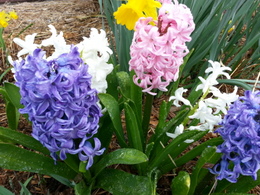Hyacinth Growing Guide
Hyacinth (Hyacinthus orientalis) is a perennial flower that is native to the eastern Mediterranean and will do well in USDA Zones 4 to 9. The bulbs are planted in the fall with bloom times from mid-spring to late-spring.
There are varieties ranging from 9 to 18-inches high and spread 4 to 6-inches wide, with colors of blue, orange, pink, purple, red, white, yellow.
Their small spiky flower stalks make them perfect in groups or in front of taller daffodils and tulips.
In addition to being deer and squirrel resistant they are a welcome sight in the spring time.
The fragrant blooms can be cut and make a beautiful table arrangement. They can also be forced indoors.
Soil Preparation
Plant your bulbs in full sun to part sun in a nice loose well-drained garden soil. They will do best in a slightly acid soil with a pH range of 6.0 to 7.0. The bulbs may rot if the soil is too wet.
When to Plant
Bulbs should be planted in the fall after the first frost, but before the ground freezes. A good time is when the soil temperature drops below 60-degrees F. The bulb needs a period of time to develop a good root system before the ground freezes. In most areas this will be around the end of October or early November.
Planting Hyacinths
Follow the grower’s instructions. In general plant the bulbs 4-inches deep and 3-inches apart. For the best visual affect plant the bulbs in groups of 3 or 5. In the colder USDA Zone 4 you can plant them 6 to 8-inches deep.
When planting the bulbs, place the bulb with the pointed end up. After planting the bulbs, cover with a light layer of mulch to conserve moisture and protect the new bulbs during the winter.
Typical blooms are 6 to 12-inches high and should be planted in front of other taller spring blooming flowers such as daffodils and tulips.
Water your bulbs every 7 to 10-days for good root development until the ground freezes.
Watering and Care
Hyacinths are low maintenance and easy to care for. All you need to do is add a layer of mulch to help retain moisture and keep out competing weeds.
Your bulbs should get an inch of water each week during their growing and blooming season and during dry spells give some water to keep the soil moist.
They usually do not need any fertilizer, but a light side dressing of low nitrogen slow release 3-5-3 organic fertilizer such as Espoma Bulb Tone can be applied. Following the directions, apply when planting and after they have finished blooming.
After the flowers have faded it is a good practice to cut off the flower spikes. Let the long strap-like leaves remain to put more energy into the bulb for next year’s flower show.
Diseases and Pests
They have no serious disease or pest problems.
Tips
Hyacinths are not as vigorous as daffodils. After a few seasons it is common for the blooms to decrease. In the first year the flower spike is packed with blooms. In the following years the old bulb becomes depleted as it sends off new bulblets and the flower spike may only have a few blooms on the spike.
To get the showy flower spike the growers do not let the hyacinth bulb bloom for several years. Workers tending the fields cut off the flower spike as it emerges to allow the bulb to get larger.
Hyacinths should not be confused with Grape hyacinths (Muscari armeniacum), which are in the same botanical family, but are not directly related.
Warnings
Hyacinth bulbs as well as the foliage and flowers contain calcium oxalate. This is poisonous to pets and other animals which avoid them. It is also in daffodils and other plants. Calcium oxalate in smaller amounts is found in beets, rhubarb, spinach and many other foods.
Sources: American Meadows, Breck’s, Eden Brothers.
Garden Spikes newsletters give you timely information once or twice a month. Subscribe Free to the Garden Times newsletter below.
Your email address will only be used to send you a newsletter and will never be sold. You can unsubscribe at any time.

